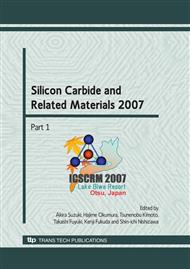p.159
p.163
p.167
p.171
p.175
p.179
p.183
p.187
p.191
In Situ Nitrogen and Aluminum Doping in Migration Enhanced Embedded Epitaxial Growth of 4H-SiC
Abstract:
The in-situ doping of aluminum and nitrogen in migration enhanced embedded epitaxy (ME3) is investigated with the aim to apply it to the realization and fabrication of all-epitaxial, normally-off 4H-SiC JFET devices. This ME3 process consists of the epitaxial growth of an n-doped channel and a highly p-doped top gate in narrow trenches. We found that the nitrogen doping in the n-channel (a-face) is a factor 1.5 higher than layers grown with the same process on Si-face wafers. Due to the low C/Si ratio and the low silane flow rate used in the ME3 process, the growth of the p-doped top gate needs high flow rates of the aluminum precursor trimethylaluminum for several hours, which contaminates the CVD reactor and causes aluminum memory effects. These aluminum memory effects can be reduced by an extra high temperature bake-out run.
Info:
Periodical:
Pages:
175-178
Citation:
Online since:
September 2008
Price:
Сopyright:
© 2009 Trans Tech Publications Ltd. All Rights Reserved
Share:
Citation:


